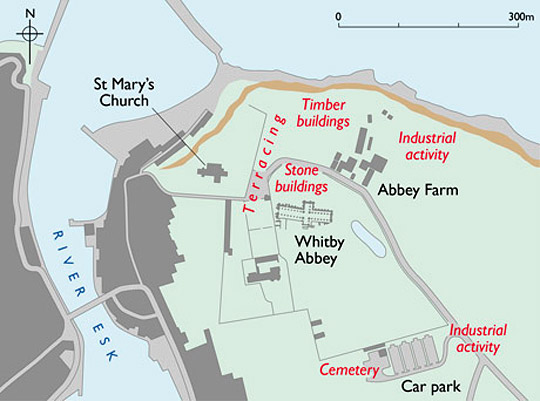Research on Whitby Abbey
Whitby is one of the largest and most important known sites associated with the 7th- and 8th-century kingdom of Northumbria to have received archaeological investigation, which has shed much light on the lost Anglian settlement. The site of the Benedictine monastery also has major archaeological potential.

Excavations
There have been several campaigns of archaeological excavation on the headland. Major clearance of the site and excavations were carried out in the 1920s under the direction of Sir Charles Peers, Principal Inspector of Ancient Monuments.[1]
Large quantities of rubble were cleared from the site. Remains of the Anglian settlement, including the footings of a group of buildings, originally interpreted as single-cell structures though more likely parts of more substantial ranges,[2] were found in the area north of the abbey church.
The area of the main monastic buildings has not yet been excavated, although geophysical survey of the site has established that there are substantial buried remains.
Between 1993 and 2008 English Heritage carried out several further excavation projects. One of these, on the cliff edge, was undertaken to record archaeology before it was lost to cliff erosion.
Here evidence for prehistoric settlement was found, although most of the remains comprised timber buildings and domestic hearths, pits and wells of the Anglian period. It is estimated that some 500 metres of the cliff has eroded away since that time, and this evidence is potentially part of a large settlement, much of which has been lost.
Excavations in 2000 on the site of the new visitor car park and entrance, south of the church, revealed part of a large Anglian cemetery. Together, these archaeological projects show that the Anglian settlement was much more extensive than had been previously thought.
Archaeological investigations were integral to the creation of a new visitor centre within the shell of the 17th-century building. Excavation of the inner courtyard of the north wing revealed a cobbled surface, with an irregular pattern formed by lines of larger stones.
This treatment seems to date from the laying-out of the courtyard in the 17th century, but its significance is unclear. It may be that the cobbles were meant to show as a pattern through an additional layer of gravel or lime concrete.
A monograph on the excavations is being prepared by English Heritage.[3]
Questions for Future Research
- Does evidence for Roman occupation survive?
- What was the extent of the Anglian settlement at Whitby?
- What was the division between monastic and lay occupation in the Anglian period?
- To what extent was the early settlement destroyed in the Danish invasions, and what form did the Danish settlement take?
- What evidence survives for the 12th-century monastic establishment?
- What is the layout of the 13th-century monastic buildings, and how was the landscape of the headland changed by terracing at this time?
- What do the Whitby Cartulary and other documentary evidence tell us about how the abbey's estates were managed, and their influence in north Yorkshire?
- How much of the present Abbey House is fabric from the monastic buildings? How were these buildings adapted by the Cholmleys as a residence?
- How does Sir Hugh Cholmley II’s new north wing of the 1670s compare with other Mannerist buildings of its time, in the north, or in England as a whole?
- How did the abbey and its setting develop as a picturesque monument and tourist attraction in the 19th and 20th centuries?
Footnotes
1. C Peers and CAR Radford, ‘The Saxon monastery of Whitby’, Archaeologia, 89 (1943), 27–88.
2. PA Rahtz, ‘Appendix C: the building plan of the Anglo-Saxon monastery of Whitby Abbey’, in The Archaeology of Anglo-Saxon England, ed DM Wilson (London, 1976), 459–62.
3. T Wilmott, The Whitby Headland Project, 1993–2013 (English Heritage, forthcoming).